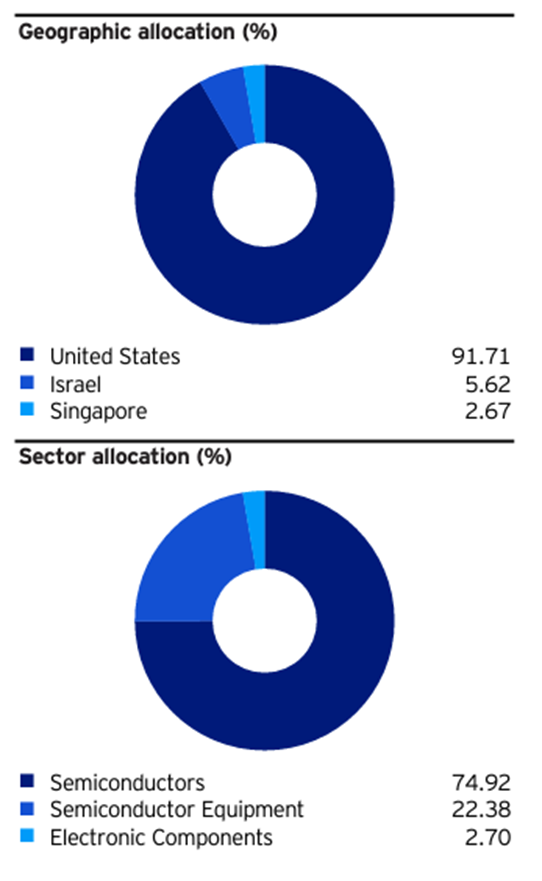Leveraged Semiconductor ETFs: Understanding Recent Investor Trends

Table of Contents
Growth and Volatility in the Semiconductor Sector
The semiconductor sector has experienced significant growth and volatility in recent years. Understanding these fluctuations is key to navigating the complexities of leveraged semiconductor ETFs.
Impact of Global Events
Geopolitical events and economic factors significantly impact semiconductor stock prices. Supply chain disruptions, trade wars, and global economic slowdowns can all lead to dramatic swings in the market.
- Trade Wars: The US-China trade war, for example, significantly impacted the semiconductor industry, creating uncertainty and affecting the prices of chips and related technology. Companies like Qualcomm and Micron experienced considerable volatility during this period.
- Supply Chain Disruptions: The COVID-19 pandemic highlighted the fragility of global supply chains, leading to shortages of semiconductors and driving up prices. This affected major players like Taiwan Semiconductor Manufacturing Company (TSMC) and Intel.
- Economic Slowdowns: Recessions and economic slowdowns often lead to decreased demand for electronics, impacting semiconductor sales and stock prices.
Technological Advancements and Their Influence
Emerging technologies are major drivers of semiconductor demand and, consequently, ETF performance.
- Artificial Intelligence (AI): The rapid growth of AI necessitates powerful and efficient semiconductors, boosting demand and influencing the performance of semiconductor ETFs.
- 5G Networks: The rollout of 5G networks requires advanced semiconductors, further fueling growth in the sector.
- Electric Vehicles (EVs): The increasing popularity of electric vehicles significantly increases the demand for specialized semiconductors used in their powertrains and electronic systems. This has a direct impact on the performance of semiconductor-focused ETFs.
Understanding Leveraged ETFs and Their Mechanics
Leveraged ETFs aim to deliver amplified returns (or losses) compared to the underlying index. However, it's crucial to understand their mechanics and inherent risks.
Risk Factors Associated with Leveraged Semiconductor ETFs
Leveraged semiconductor ETFs magnify both gains and losses, making them inherently riskier than traditional ETFs.
- Daily Reset: Leveraged ETFs reset their leverage daily. This means that if the underlying index experiences significant daily fluctuations, the ETF's performance may deviate substantially from its target multiple over longer periods.
- Compounding Losses: In a downturn, daily losses can compound, resulting in much larger overall losses than the underlying index.
- Long-Term Holding: Leveraged ETFs are generally not suitable for long-term investments due to the compounding effect of daily resets and the potential for significant deviations from the target leverage.
Choosing the Right Leveraged Semiconductor ETF
Selecting a suitable leveraged semiconductor ETF requires careful consideration of several factors.
- Expense Ratio: A lower expense ratio translates into lower costs and higher returns.
- Underlying Index: The ETF's performance is directly tied to the performance of its underlying index. Choose an index that aligns with your investment goals and risk tolerance.
- Investment Strategy: Consider the ETF's investment strategy and how it aims to achieve its leverage target. Some ETFs utilize futures contracts, while others use swaps or other derivative instruments. Examples include (mention specific ETF tickers here, e.g., SOXL, but always conduct your own research before investing).
Recent Investor Trends in Leveraged Semiconductor ETFs
Analyzing recent trading volumes and investor sentiment provides valuable insights into market behavior.
Analyzing Investor Behavior During Market Upswings and Downswings
Investor behavior changes significantly depending on market conditions.
- Bull Markets: During bull markets, investors often flock to leveraged semiconductor ETFs seeking amplified returns, leading to increased inflows.
- Bear Markets: Conversely, during bear markets, investors often withdraw from leveraged ETFs to limit their losses, resulting in significant outflows. This can amplify losses due to the daily reset mechanism.
The Role of Short-Term and Long-Term Investors
Different investor types have varying strategies and risk tolerances.
- Short-Term Investors: Short-term investors often utilize leveraged semiconductor ETFs for short-term trading opportunities, capitalizing on short-term price swings. They are more tolerant of increased volatility.
- Long-Term Investors: Long-term investors generally avoid leveraged ETFs due to the compounding effect of daily resets and the amplified risk of prolonged market downturns.
Conclusion
Leveraged semiconductor ETFs offer the potential for significant returns, but they also carry substantially elevated risk. Understanding recent investor trends, the mechanics of leveraged ETFs, and the inherent volatility of the semiconductor sector is crucial for making informed investment decisions. Before investing in leveraged semiconductor ETFs, carefully assess your risk tolerance and investment goals. Conduct thorough research and consider consulting a financial advisor to determine if this investment strategy aligns with your financial plan. Don't let the allure of amplified returns overshadow the potential for amplified losses. Remember to thoroughly research different leveraged semiconductor ETFs to find the one that best suits your individual needs and risk profile.

Featured Posts
-
 Salman Khans Film A 4 7 Budget Return Box Office Analysis
May 13, 2025
Salman Khans Film A 4 7 Budget Return Box Office Analysis
May 13, 2025 -
 Metas Acquisitions Under Scrutiny The Ftcs Antitrust Case For Whats App And Instagram
May 13, 2025
Metas Acquisitions Under Scrutiny The Ftcs Antitrust Case For Whats App And Instagram
May 13, 2025 -
 Mlb Home Run Prop Bets Today April 26th Tucker And More
May 13, 2025
Mlb Home Run Prop Bets Today April 26th Tucker And More
May 13, 2025 -
 Serie A Ac Milan Vs Atalanta Guia Completa Para Ver A Gimenez
May 13, 2025
Serie A Ac Milan Vs Atalanta Guia Completa Para Ver A Gimenez
May 13, 2025 -
 Eva Longorias Stunning New Hair A Transformation We Love
May 13, 2025
Eva Longorias Stunning New Hair A Transformation We Love
May 13, 2025
